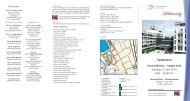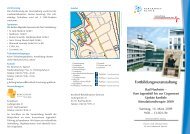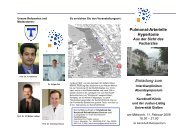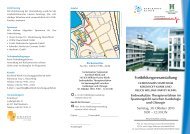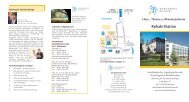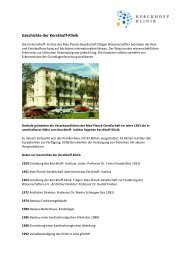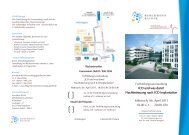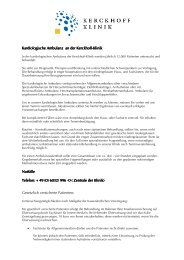Spotlight: Christian W. Hamm, MD, PhD, FESC ... - Kerckhoff-Klinik
Spotlight: Christian W. Hamm, MD, PhD, FESC ... - Kerckhoff-Klinik
Spotlight: Christian W. Hamm, MD, PhD, FESC ... - Kerckhoff-Klinik
Create successful ePaper yourself
Turn your PDF publications into a flip-book with our unique Google optimized e-Paper software.
European Perspectives<br />
Circulation 2009;119;f115-f120<br />
DOI: 10.1161/CIRCULATIONAHA.109.192204<br />
Circulation is published by the American Heart Association. 7272 Greenville Avenue, Dallas, TX 72514<br />
Copyright © 2009 American Heart Association. All rights reserved. Print ISSN: 0009-7322. Online ISSN:<br />
1524-4539<br />
The online version of this article, along with updated information and services, is located<br />
on the World Wide Web at:<br />
http://circ.ahajournals.org<br />
Subscriptions: Information about subscribing to Circulation is online at<br />
http://circ.ahajournals.org/subscriptions/<br />
Permissions: Permissions & Rights Desk, Lippincott Williams & Wilkins, a division of Wolters<br />
Kluwer Health, 351 West Camden Street, Baltimore, <strong>MD</strong> 21202-2436. Phone: 410-528-4050. Fax:<br />
410-528-8550. E-mail:<br />
journalpermissions@lww.com<br />
Reprints: Information about reprints can be found online at<br />
http://www.lww.com/reprints<br />
Downloaded from<br />
circ.ahajournals.org by on May 28, 2009
Circulation May 26, 2009<br />
On other pages...<br />
European Perspectives in Cardiology<br />
<strong>Spotlight</strong>: <strong>Christian</strong> W. <strong>Hamm</strong>,<br />
<strong>MD</strong>, <strong>PhD</strong>, <strong>FESC</strong>, FACC, FAHA<br />
Renowned in Germany as an Interventionist and Renowned<br />
Elsewhere for His 1992 Article on the Prognostic Potential of Troponin<br />
<strong>Christian</strong> W. <strong>Hamm</strong>, professor of internal medicine and cardiology and<br />
medical director of the <strong>Kerckhoff</strong> Heart and Thorax Centre,<br />
Bad �auheim, Germany, talks to Jennifer Taylor, BSc, MSc, MPhil.<br />
In Germany he is known as an interventional cardiologist;<br />
elsewhere people think of biomarkers when his name is<br />
mentioned. Now professor of internal medicine and cardiology<br />
and medical director of the <strong>Kerckhoff</strong> Heart and<br />
Thorax Centre in Bad Nauheim, Germany, <strong>Christian</strong> W.<br />
<strong>Hamm</strong>, <strong>MD</strong>, <strong>FESC</strong>, FACC, FAHA, is a third-generation<br />
doctor—both his father and grandfather were “very dedicated”<br />
general practitioners, and his father was a professor<br />
of family medicine. His middle initial stands for Wilhelm,<br />
his grandfather’s name.<br />
After high school, <strong>Hamm</strong> chose to study German literature,<br />
which his father said was fine provided he studied medicine<br />
as well. After 1 year, medicine won over the literature. “The<br />
people were more interesting and the practical work in the<br />
hospital really attracted me,” he says. “I was interested not<br />
only in working with my brain but also with my hands.<br />
That’s also a reason why I ended up in cardiology because<br />
it’s a field where you can do both.”<br />
On completion of medical school at the University of<br />
Hamburg, Hamburg, Germany, <strong>Hamm</strong> wanted to pursue<br />
research. Most people went to the United States, but he<br />
obtained a research grant from the Deutsche Forschungsgemeinschaft<br />
(German Research Foundation) to go to the<br />
Team 2009: The <strong>Kerckhoff</strong> Heart and Thorax Centre in Bad �auheim, Germany<br />
<strong>Christian</strong> W. <strong>Hamm</strong>, <strong>MD</strong>, <strong>PhD</strong>, <strong>FESC</strong>, FACC, FAHA, medical director, executive director,<br />
and managing director of research of the <strong>Kerckhoff</strong> Heart and Thorax Centre, Bad Nauheim,<br />
Germany, describes how the 6 research teams at the <strong>Kerckhoff</strong> Heart and Thorax Centre share their<br />
expertise in biomarkers and noninvasive imaging and translating it to other research fields to provide<br />
high-quality patient care and develop new and better therapeutic options.<br />
Page f119<br />
Downloaded from<br />
circ.ahajournals.org by on May 28, 2009<br />
laboratory of Professor Lionel H. Opie, <strong>MD</strong>, DPhil, DSc,<br />
FRCP, at the University of Cape Town, Cape Town, South<br />
Africa. So, from 1980 to 1981 he did basic research, primarily<br />
animal experiments, as a research fellow in the<br />
Ischaemic Heart Research Unit. He says, “It was a very<br />
nice time to be in Cape Town, which is one of the most<br />
beautiful cities you can think of. There I learned how to<br />
write scientific papers, how to think scientifically, how to<br />
approach problems from a scientific point of view. I<br />
learned a lot about science from Professor Opie, who was<br />
a very good teacher. ” <strong>Hamm</strong> also describes Professor Opie<br />
as “a very strict person” and “very English.”<br />
The time in Cape Town provided <strong>Hamm</strong> with an opportunity<br />
to improve his English, which he had learned during<br />
the year he spent as an exchange student in Michigan, MI,<br />
while in high school. The result was that he arrived in Cape<br />
Town as a German speaking English with an American<br />
accent. “That was a little bit strange,” he recalls with a<br />
laugh. He has since added a South African layer to his<br />
American accent.<br />
<strong>Hamm</strong> returned to the Department of Cardiology at the<br />
University of Hamburg in 1981, intent on improving his<br />
clinical skills. In 1982, he had the opportunity to work in<br />
f115<br />
Circulation: European Perspectives
f116<br />
Circulation: European Perspectives<br />
Circulation May 26, 2009<br />
the catheterisation laboratory thanks to his clinical teacher,<br />
Professor Walter Bleifeld, <strong>MD</strong>. Professor <strong>Hamm</strong> says,<br />
“That was in the beginning of the 80s when coronary intervention<br />
and balloon angioplasty started, and later stents and<br />
so on, and I was very early in that field. I have close to 27<br />
years of interventional experience, which is quite a long<br />
time now.”<br />
As a young fellow, <strong>Hamm</strong>, together with colleagues,<br />
built up the interventional programme at the University of<br />
Hamburg. During this early part of his career, his focus was<br />
less on research and more on improving his skills in the<br />
catheterisation laboratory. He says, “That’s the reason why<br />
in Germany I’m much more known than outside of<br />
Germany for interventional cardiology. Probably outside<br />
Germany no one knows that I am still quite active in the<br />
cath lab.”<br />
The longevity of his practice in this area has given<br />
Professor <strong>Hamm</strong> a reputation for being one of the most<br />
experienced interventional cardiologists in Germany.<br />
Despite being in charge of a big cardiac centre and the<br />
administrative work which that entails, he still performs at<br />
least 500 procedures each year, which he estimates “is<br />
probably much more than the others in my field are doing.”<br />
His caseload consists of private patients and complex referral<br />
cases that other hospitals don’t want or at which they<br />
have been unsuccessful. “I enjoy doing things when others<br />
give up,” he says.<br />
Another important influence at the University of<br />
Hamburg was Professor Thomas Meinertz, <strong>MD</strong>, chair of<br />
cardiology. “He taught me during my last years in<br />
Hamburg how to talk to patients and that good communication<br />
is an important aspect for being a good doctor,” says<br />
Professor <strong>Hamm</strong>. “You not only have to know the facts, but<br />
you have to sell it to the patient to convince him.”<br />
During the early part of his career, Professor <strong>Hamm</strong>’s focus was less on<br />
research and more on improving his skills in the catheterisation laboratory.<br />
He says, “That’s the reason why in Germany I’m much more known than<br />
outside of Germany for interventional cardiology. Probably outside Germany<br />
no one knows that I am still quite active in the cath lab.” Photographs courtesy<br />
of Professor <strong>Hamm</strong>.<br />
Downloaded from<br />
circ.ahajournals.org by on May 28, 2009<br />
“The Advantage of This �onprofit Foundation Is That<br />
Most of the Profit We Make Can Go Into Research”<br />
Professor <strong>Hamm</strong>’s current position in Bad Nauheim is<br />
unique for Germany. Since 1999, he has been full professor<br />
of cardiology in the State of Hessen and chief of cardiology<br />
at the <strong>Kerckhoff</strong> Heart Centre, as it was known at the time.<br />
For the past 2 years, he has also been medical director and<br />
research director, and since 2008 he has been chief executive<br />
officer. The centre became the only nonprofit foundation<br />
of its type in Germany in 1999, the day Professor<br />
<strong>Hamm</strong> took up his post. It has close links to the university<br />
and to the Max Planck Institute for Heart and Lung<br />
Research.<br />
Professor <strong>Hamm</strong> explains, “We also used to be a Max<br />
Planck Institute, but it was too difficult for a research<br />
organisation to run a hospital, so we changed to this nonprofit<br />
foundation. The advantage is that we can reinvest all<br />
the profit we make here—and in such a place you make<br />
some profit. Today we can decide how to reinvest this profit<br />
in patient care and research.”<br />
The government, the State of Hessen, is one of the owners<br />
of the foundation, together with the Max Planck Institute,<br />
and representatives from each make up the board. The<br />
setup makes his job easy as chief executive officer, says<br />
Professor <strong>Hamm</strong>, because he has autonomy in decision<br />
making, which means that choices about where to invest<br />
money are very straightforward. Since becoming a foundation,<br />
more money is actually available for research.<br />
The hospital at the centre is one of the largest in<br />
Germany. It features a cardiology unit with 128 beds, a<br />
large intensive care unit, an active and well-known electrophysiology<br />
group that does a lot of procedures, the<br />
catheterisation laboratory—Professor <strong>Hamm</strong>’s favourite<br />
section—and a noninvasive diagnostics unit with 2 magnetic
Circulation May 26, 2009<br />
<strong>Kerckhoff</strong> Heart and Thorax<br />
Centre in Bad �auheim,<br />
Germany, where Professor<br />
<strong>Hamm</strong> is professor of internal<br />
medicine and cardiology,<br />
medical director, research<br />
director, and since 2008, chief<br />
executive officer. Professor<br />
<strong>Hamm</strong> says, “We used to be a<br />
Max Planck Institute, but it<br />
was too difficult for a research<br />
organisation to run a hospital,<br />
so we changed to a nonprofit<br />
foundation. The advantage is<br />
that we can reinvest all the<br />
profit we make here—and in<br />
such a place you make some<br />
profit. Today we can decide<br />
how to reinvest this profit in<br />
patient care and research.”<br />
Photo courtesy of Professor<br />
<strong>Hamm</strong>.<br />
resonance imaging (MRI) units and 1 computed tomography<br />
(CT) unit. Cardiologists in the unit carry out 2500<br />
MRIs of the heart per year, more than in any other centre in<br />
Germany. Professor <strong>Hamm</strong> says, “In many other parts of<br />
the world and Germany MRIs and CTs are done by radiologists,<br />
but here we do it ourselves.”<br />
“That’s What I’m Known for Outside of Germany—<br />
How to Use Biomarkers in Clinical Practice, and the<br />
Breakthrough Was This First Article on Troponin in<br />
Acute Coronary Syndrome”<br />
Professor <strong>Hamm</strong>’s four most important publications have<br />
all been published in the �ew England Journal of Medicine<br />
with him as first author and reflect his 2 major fields of<br />
research activity: biomarkers and interventional cardiology.<br />
The first, published in 1992, was the first report ever published<br />
on the prognostic potential of troponin. 1 His group<br />
found that troponin was a marker for outcome in patients<br />
with acute coronary syndrome. “Today measurement of<br />
troponin in the coronary care unit or in the emergency unit<br />
is routine, so that’s something I should be proud of,” says<br />
Professor <strong>Hamm</strong>. “That’s what I’m known for outside of<br />
Germany—how to use biomarkers in clinical practice, and<br />
the breakthrough was this first article on troponin in acute<br />
coronary syndrome.” In 1997, his group showed that measuring<br />
troponin routinely in the emergency unit improved<br />
decision making and had an effect on outcome. 2<br />
A third study, published in 1999, closed the loop by providing<br />
a therapeutic answer. They investigated how to treat<br />
patients with an increased risk as described by elevated<br />
troponin and showed for the first time that these patients<br />
benefited from potent antiplatelet treatment. 3<br />
Professor <strong>Hamm</strong> is still actively working on biomarkers,<br />
and a number of articles on novel biomarkers have been<br />
Downloaded from<br />
circ.ahajournals.org by on May 28, 2009<br />
published by his fellows in Circulation, the �ew England<br />
Journal of Medicine, and the Lancet. “We are still looking<br />
for perfect biomarkers for the emergency room in terms of<br />
inflammation,” he says. Although many biomarkers have<br />
been identified, they would prefer to identify others that are<br />
more specific for cardiac events.<br />
A fourth important article, this time in interventional<br />
cardiology, was published in 1994. 4 “It is still cited today<br />
as one of the early trials that compares interventional cardiology,<br />
balloon angioplasty, with bypass surgery,” says<br />
Professor <strong>Hamm</strong>. “The key finding was that balloon angioplasty—this<br />
was before stents—is, in terms of mortality,<br />
equivalent to bypass surgery in multivessel disease.”<br />
Professor <strong>Hamm</strong>’s Interventional Research �ow Takes<br />
the Form of Multicentre Studies, of Which He Is Either<br />
Principal Investigator or on the Steering Committee<br />
One of the most interesting of these multicentre studies is<br />
the Paclitaxel-Eluting PTCA-Balloon in combination with<br />
the Coroflex Blue Stent (Coroflex DEBlue system) vs the<br />
Sirolimus Coated Cypher Stent in the treatment of<br />
advanced Coronary Artery Disease (PEPCAD-III) study,<br />
which is investigating the new concept of a drug-eluting<br />
balloon.<br />
Professor <strong>Hamm</strong> is also fond of the Ongoing Tirofiban<br />
in Myocardial Infarction Evaluation (On-TIME) 2 trial 5<br />
because it reflects his passion for taking treatment out to<br />
patients. In ON-TIME 2, a multicentre study done with a<br />
Dutch group, patients with ST-elevation myocardial infarction<br />
were given a glycoprotein IIb/IIIa antagonist in the<br />
ambulance en route to the catheterisation laboratory. “The<br />
finding was that it improves the ECG but did not result in<br />
a difference in outcome because the study was too small,”<br />
says Professor <strong>Hamm</strong>. Germany has the highest density of<br />
f117<br />
Circulation: European Perspectives
f118 Circulation May 26, 2009<br />
Circulation: European Perspectives<br />
Professor <strong>Hamm</strong> says, “Professor Eugene Braunwald was my good mentor for acute coronary<br />
syndrome, and we have been good friends for 20 years. Here we are Professor Braunwald (left)<br />
and Professor Antman (right) celebrating 20 years of unstable angina [research] at a symposium<br />
in Hamburg.” Photograph courtesy of Professor <strong>Hamm</strong>.<br />
catheterisation laboratories in Europe, and every patient<br />
with ST-elevation myocardial infarction can be taken to the<br />
catheterisation laboratory. One of Professor <strong>Hamm</strong>’s<br />
goals is to improve the treatment of these patients during<br />
transport.<br />
On top of his own research in interventional cardiology<br />
and biomarkers, the centre has a basic science research<br />
group that carries out stem cell research and a group that<br />
studies noninvasive imaging, including cardiac magnetic<br />
resonance imaging and computed tomography.<br />
This year Professor <strong>Hamm</strong> has received a major honour<br />
in interventional cardiology because he will give the<br />
Andreas Grüntzig Lecture on Interventional Cardiology,<br />
which is 1 of 4 named lectures at the annual congress of the<br />
European Society of Cardiology (ESC) In 2008, his life<br />
work on biomarkers and interventional cardiology was<br />
acknowledged with one of the most important prizes in<br />
Germany, the Paul Morawitz Prize, which is presented<br />
annually by the Germany Society of Cardiology.<br />
“Because I Am Still Very Active in Clinical Work,<br />
Writing Guidelines Is Something That Interests Me”<br />
Bad Nauheim, Germany, where Professor <strong>Hamm</strong> works, is<br />
the birthplace of the German Society of Cardiology, but the<br />
small town’s historical significance extends beyond<br />
Germany. The American College of Cardiology was founded<br />
there after World War II. Add into the mix that Bad<br />
Nauheim hosts Germany’s only Max Planck Institute for<br />
Heart Research, and the town has become the most important<br />
centre for cardiology in the country. As such, Bad<br />
Nauheim holds the most fruitful work opportunities for<br />
Professor <strong>Hamm</strong>, but he misses the sea breeze of his own<br />
birthplace, Hamburg. He still has an apartment there and<br />
frequently visits with his wife at weekends. “People who<br />
Downloaded from<br />
circ.ahajournals.org by on May 28, 2009<br />
know me know I miss the sea<br />
and I’m a little bit lost here,” he<br />
says. “I need the sea from time to<br />
time.”<br />
From a work point of view,<br />
some of his happiest moments are<br />
completing an article or one of<br />
the many guidelines for which he<br />
is known. He enjoys writing and<br />
has just finished the guideline for<br />
acute coronary syndrome in<br />
Germany. In Germany, he has<br />
also been chair of the writing<br />
committee for guidelines on<br />
myocardial infarction and diagnostic<br />
catheterisation, in addition<br />
to many others. He has also<br />
taken part in several guideline<br />
committees for the European<br />
Society of Cardiology. For example,<br />
he cochaired its committee for<br />
the guidelines on acute coronary<br />
syndrome without ST elevation,<br />
which were published in 2007.<br />
Professor <strong>Hamm</strong> says he enjoys contributing to guidelines<br />
because he is always looking for ways to translate<br />
research results into patient care. He explains, “Guidelines<br />
are a very good opportunity to interpret scientific evidence<br />
and interpret studies and make recommendations for clinical<br />
practice. And because I am still very active in clinical<br />
work, this is something that interests me.”<br />
References<br />
1. <strong>Hamm</strong> CW, Ravkilde J, Gerhardt W, Jørgensen P, Peheim E, Ljungdahl<br />
L, Goldmann B, Katus HA. The prognostic value of serum troponin T<br />
in unstable angina. � Engl J Med. 1992;327:146–150.<br />
2. <strong>Hamm</strong> CW, Goldmann BU, Heeschen C, Kreymann G, Berger J,<br />
Meinertz T. Emergency room triage of patients with acute chest pain by<br />
means of rapid testing for cardiac troponin T or troponin I. � Engl J<br />
Med. 1997;337:1648–1653.<br />
3. <strong>Hamm</strong> CW, Heeschen C, Goldmann B, Vahanian A, Adgey J, Miguel<br />
CM, Rutsch W, Berger J, Kootstra J, Simoons ML. Benefit of abciximab<br />
in patients with refractory unstable angina in relation to serum troponin<br />
T levels. c7E3 Fab Antiplatelet Therapy in Unstable Refractory<br />
Angina (CAPTURE) study investigators. � Engl J Med. 1999;340:<br />
1623–1629.<br />
4. <strong>Hamm</strong> CW, Reimers J, Ischinger T, Rupprecht HJ, Berger J, Bleifeld W.<br />
A randomized study on coronary angioplasty compared with bypass<br />
surgery in patients with symptomatic multivessel coronary disease.<br />
German Angioplasty Bypass Surgery Investigation (GABI). � Engl J<br />
Med. 1994;331:1037–1043.<br />
5. Van't Hof AW, Ten Berg J, Heestermans T, Dill T, Funck RC, van<br />
Werkum W, Dambrink JH, Suryapranata H, van Houwelingen G,<br />
Ottervanger JP, Stella P, Giannitsis E, <strong>Hamm</strong> C, Ongoing Tirofiban In<br />
Myocardial infarction Evaluation (On-TIME) 2 study group.<br />
Prehospital initiation of tirofiban in patients with ST-elevation myocardial<br />
infarction undergoing primary angioplasty (On-TIME 2): a multicentre,<br />
double-blind, randomised controlled trial. Lancet. 2008;<br />
372:537–546.<br />
Jennifer Taylor is a freelance medical journalist.
Circulation May 26, 2009<br />
Team 2009: The <strong>Kerckhoff</strong> Heart and Thorax<br />
Centre in Bad �auheim, Germany<br />
“A Team Built on Early Promotion and Taking Responsibility at a Young Age”<br />
<strong>Christian</strong> W. <strong>Hamm</strong>, <strong>MD</strong>, <strong>PhD</strong>, <strong>FESC</strong>, FACC, FAHA, medical director, executive director,<br />
and managing director of research of the <strong>Kerckhoff</strong> Heart and Thorax Centre, Bad �auheim,<br />
Germany, describes the team and how it works to Jennifer Taylor, BSc, MSc, MPhil.<br />
Staff of the <strong>Kerckhoff</strong> Heart and Thorax Centre in Bad �auheim, Germany. Photograph courtesy of Professor <strong>Hamm</strong>.<br />
The 35 fellows and 12 consultants at The <strong>Kerckhoff</strong><br />
Heart and Thorax Centre in Bad Nauheim, Germany,<br />
are divided into 6 research teams, each focusing on a key<br />
area of research as follows:<br />
● invasive cardiology and biomarkers, led by Associate<br />
Professor Michael Weber, <strong>MD</strong>, <strong>PhD</strong>;<br />
Downloaded from<br />
circ.ahajournals.org by on May 28, 2009<br />
● noninvasive imaging led by Professor Thorsten Dill,<br />
<strong>MD</strong>, <strong>PhD</strong>;<br />
● heart failure (pharmacology and transplant), led by<br />
Professor Veselin Mitrovic, <strong>MD</strong>, <strong>PhD</strong>;<br />
● electrophysiology (atrial fibrillation), led by Heinz<br />
Pitschner, <strong>MD</strong>, <strong>PhD</strong>;<br />
f119<br />
Circulation: European Perspectives
f120 Circulation May 26, 2009<br />
Circulation: European Perspectives<br />
● pacemaker/implantable cardioverter-defibrillators (new<br />
devices), led by Johannes Sperzel, <strong>MD</strong>; and<br />
● echocardiography (myocardial function), led by Roland<br />
Brandt, <strong>MD</strong>.<br />
In addition, a research group for basic science (stem<br />
cells, myocardial regeneration, Tako Tsubo cardiomyopathy)<br />
carries out both bench and animal research in a<br />
500m 2 research laboratory. This group has 8 members<br />
including a biochemist and is led by Helge Möllmann, <strong>MD</strong>,<br />
and Holger Nef, <strong>MD</strong>.<br />
More information can be obtained from the team’s Web<br />
site, www.kerckhoff-klinik.de, which is primarily in German.<br />
Areas of research include the investigation of biomarkers<br />
in valve disease and acute coronary syndrome, using cryotechniques<br />
to treat atrial fibrillation ablation, and the study<br />
of mechanisms in Tako Tsubo cardiomyopathy. 1–6<br />
“Come to Work Smiling”<br />
In general, Professor <strong>Hamm</strong> says, the 6 research teams work<br />
together by using their expertise in biomarkers and noninvasive<br />
imaging and translating it to other research fields.<br />
One focus is Tako Tsubo cardiomyopathy, which is<br />
investigated by the invasive, magnetic resonance imaging<br />
(MRI), and basic science research groups. The aim is to<br />
better define the mechanisms that lead to this disease. The<br />
invasive and basic science groups also look for mechanisms<br />
in restenosis and target drugs.<br />
The electrophysiology group cooperates closely with the<br />
noninvasive imaging (MRI/computed tomography) group<br />
in improving imaging guidance during ablation procedures.<br />
The biomarker research provides many links to the heart<br />
failure and imaging research groups.<br />
Professor <strong>Hamm</strong> says the <strong>Kerckhoff</strong> Heart and Thorax<br />
Centre team is highly committed and enjoys doing<br />
research. “They must come to work smiling, otherwise<br />
there is no sense in spending so much time of your life in<br />
the hospital or research labs,” he explains. His philosophy<br />
is to promote research fellows early and to give them<br />
responsibility at a young age. “This ensures an open<br />
minded approach and willingness to cooperate,” he says.<br />
“I understand myself only as a mediator. At my level I<br />
need no further promotion, but they appreciate the support,<br />
I think.”<br />
A highly professional research team with study nurses<br />
has been established for conducting industry and investigatorinitiated<br />
multicentre trials, resulting in involvement in up<br />
to 80 studies. The team itself has initiated important studies<br />
such as the German Angioplasty Bypass Surgery<br />
Investigation (GABI) study, 7 the recent Ongoing Tirofiban<br />
In Myocardial infarction Evaluation (ON-TIME) 2 study, 6<br />
and the ongoing Paclitaxel-Eluting PTCA-Balloon in combination<br />
with the Coroflex Blue Stent (Coroflex DEBlue<br />
system) vs the Sirolimus Coated Cypher Stent in the<br />
Editor: Helmut Drexler, <strong>MD</strong>, <strong>FESC</strong><br />
Managing Editor: Lindy van den Berghe, BMedSci, BM, BS<br />
We welcome comments. E-mail lindy@circulationjournal.org<br />
Downloaded from<br />
circ.ahajournals.org by on May 28, 2009<br />
treatment of advanced Coronary Artery Disease (PEPCAD)<br />
III study, which investigates a new drug-eluting balloon.<br />
Close Links to Medical Research Benefit the Patients<br />
The 289-bed <strong>Kerckhoff</strong> Clinic has an excellent reputation<br />
as one of the largest and best known cardiac, lung, and<br />
rheumatology clinics in Germany, providing treatment for<br />
more than 38000 patients each year.<br />
The cardiology unit has 128 beds and special units that<br />
focus on specific disorders. Approximately 10000 patients<br />
attend the cardiology outpatient department and over 2500<br />
heart operations requiring the heart–lung machine are carried<br />
out each year. The range of surgery includes treating<br />
patients with dilated cardiomyopathy (DCM), and special<br />
experience in mitral valve reconstruction (the maze operation,<br />
and a further development, the mini maze operation).<br />
Ongoing research projects include investigating DCM, cardiac<br />
arrhythmia, and neurological complications after heart<br />
surgery.<br />
References<br />
1. Dill T, Schächinger V, Rolf A., Möllmann S, Thiele H, Assmus B,<br />
Tillmanns H, Dimmeler S, Zeiher A, <strong>Hamm</strong> CW. Left ventricular function<br />
after intracoronary infusion of bone marrow-derived progenitor<br />
cells after acute STEMI: MRI substudy of the double-blind, randomized,<br />
placebo-controlled multicenter REPAIR-AMI trial. Am Heart J.<br />
2009;157:541–547.<br />
2. Rolf A, Nef HM, Möllmann H, Troidl C, Voss S, Conradi G, Rixe J,<br />
Steiger H, Beiring K, <strong>Hamm</strong> CW, Dill T. Immunohistological basis of<br />
the late gadolinium enhancement phenomenon in Tako-Tsubo cardiomyopathy.<br />
Eur Heart J. 2009 Apr 23. [Epub ahead of print]<br />
3. Neumann T, Vogt J, Schumacher B, Dorszewski A, Kuniss M, Neuser<br />
H, Kurzidim K, Berkowitsch A, Koller M, Heintze J, Scholz U, Wetzel<br />
U, Schneider MA, Horstkotte D, <strong>Hamm</strong> CW, Pitschner HF.<br />
Circumferential pulmonary vein isolation with the cryoballoon technique<br />
results from a prospective 3-center study. J Am Coll Cardiol.<br />
2008;52:273–278.<br />
4. Nef H, Möllmann H, Kostin S, Troidl C, Voss S, Weber M, Dill T, Rolf<br />
A, Brandt R, <strong>Hamm</strong> CW, Elsässer A. Tako-Tsubo cardiomyopathy:<br />
intraindividual structural analysis in the acute phase and after functional<br />
recovery. Eur Heart J. 2007;28:2456–2464.<br />
5. Möllmann H, Nef H, Kostin S, von Kalle C, Pilz I, Weber M, Schaper<br />
J, <strong>Hamm</strong> CW, Elsässer A. Bone marrow-derived cells contribute to<br />
infarct remodeling. Cardiovasc Res. 2006;71:661–671.<br />
6. Van't Hof AW, Ten Berg J, Heestermans T, Dill T, Funck RC, van<br />
Werkum W, Dambrink JH, Suryapranata H, van Houwelingen G,<br />
Ottervanger JP, Stella P, Giannitsis E, <strong>Hamm</strong> C; Ongoing Tirofiban In<br />
Myocardial infarction Evaluation (On-TIME) 2 study group.<br />
Prehospital initiation of tirofiban in patients with ST-elevation<br />
myocardial infarction undergoing primary angioplasty (On-TIME 2): a<br />
multicentre, double-blind, randomised controlled trial. Lancet. 2008;<br />
372:537–546.<br />
7. <strong>Hamm</strong> CW, Reimers J, Ischinger T, Rupprecht HJ, Berger J, Bleifeld<br />
W. A randomized study on coronary angioplasty compared with bypass<br />
surgery in patients with symptomatic multivessel coronary disease.<br />
German Angioplasty Bypass Surgery Investigation (GABI). � Engl J<br />
Med. 1994;331:1037–1043.<br />
Jennifer Taylor is a freelance medical journalist.<br />
The opinions expressed in Circulation: European Perspectives<br />
in Cardiology are not necessarily those of the editors or of<br />
the American Heart Association.



